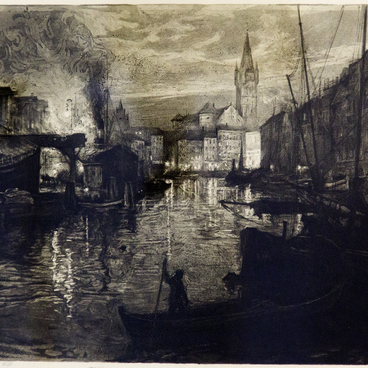Helene Neumann (1874—1942) was one of the most famous artists in East Prussia. She was fortunate to be raised in a very wholesome creative and scholarly environment. Her grandfather Frantz Neumann was a well-known physicist, her father Ernst Neumann — a pathologist, her aunt Luisa Neumann — a popular portrait painter, and her uncle Ernst August Hagen — the first professor of the Arts History Department in Albertina.
High Shore near Brusterort
Время создания
Early 20th century
Размер
20x26 cm
Техника
Paper, etching
0
Открыть в приложении#1
Helene Neumann
High Shore near Brusterort
#3
#4
In 1902, Neumann got enlisted to the first ever female artistic class in Konigsberg Academy of Fine Arts created thanks to the efforts of Heinrich Wolff — another outstanding graphics artist.
#5
‘Heinrich Wolff was a good advisor. He opened my eyes to the marvelous light spreading by the shore, especially on the Curonian Spit…’,
Helene wrote.
#6
The majority of her pieces is dedicated to the views of Sambland Peninsula with its steep shores and deep marine coloring. She also often painted landscapes remembering her trips to Italy. Neumann mainly used the techniques of lithography and watercolors. She was an active participant in the exhibitions by Konigsberg Union of Artists, as well as in Berlin. Many of her pieces were published as post cards and calendar pages, and were very popular in the first three decades of the 20th century.
#7
Neumann dedicated a lot of time and effort to social work: she was fighting for women’s rights in East Prussia, supported the Housemaids Union and even converted an old fisherman’s house into a resort for them.
Neumann created the etching High Shore near Brusterort in the early 1900-s. During this period, she moved to a new house in Rauschen (today’s Svetlogorsk), where she lived till the end of her life. Starting from that moment, nature became one of her main topics.
#8
Neumann paid great attention to the finest details of the life of nature, and the etching technique allowed her to trace them very clearly. This technique implies drawing on a metal plate (most often, the copper one), and then putting the plate into the acid solution — thus the image appeared to be more prominent. During printing, the dye from the scratched and etched lines passed to paper.
#9
The piece High Shore near Brusterort is full of lyrical feelings: desolated seashore with its steep rocks looks almost tangible. Despite intense social activity, Neumann never showed it in her work and remained faithful to the landscape genre.
#10
Kaliningrad Regional Museum of Fine Arts
читать дальшескрыть
00:00
00:00
1x
High Shore near Brusterort
Время создания
Early 20th century
Размер
20x26 cm
Техника
Paper, etching
0
Открыть в приложении
Поделиться

